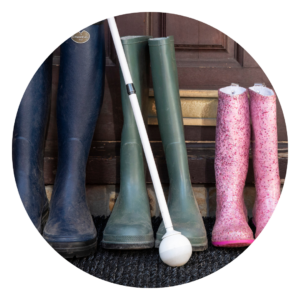We’d like to take this opportunity to share some myths and learnings about canes, which can be such an invaluable tool for many blind and partially sighted people, who are keen to navigate their surroundings with independence.
MYTH 1 – Canes are all the same.
Canes might appear the same but small variations can make them ideally suited for various purposes and to communicate different things:
Long Canes: Probably the type you’re most familiar with. Long canes extend from the floor to the user’s sternum and are used to avoid obstacles. The tips of these canes can be altered for different purposes:
- A mushroom tip has a large surface area to provide lots of feedback about the terrain.
- A silver circle tip is durable and can easily glide over cracks, as well as give audio feedback about the surface. – A ceramic tip is excellent for providing audio and tactile feedback but lacks durability.
- A rolling marshmallow tip can rotate to 360 degrees and since it is in constant touch with the ground, it offers feedback about every change in the surface.
- A ball tip is almost the size of an orange and rotates just like a marshmallow tip. It is mostly used by people who are just learning to use a cane.
Guide Cane: This shorter cane is used to catch any immediate obstacles such as curbs and steps. It is typically held across the user’s body and while it doesn’t have as much range it can still be a useful tool.
Symbol Cane: Perhaps less commonly known, these canes are good for people with low but useful vision who want to let people around them known that they are partially sighted. While this cane is smaller than the standard long cane, it can be useful in busy locations.
Different Colour Canes: While an all-white cane typically means that the user has no usable vision, a white cane with a red bottom means that the user has low vision. A white and red striped cane is usually used by someone who is totally blind and/or deaf.
MYTH 2 – All blind and partially sighted people use canes.
There’s a common misconception that all blind and partially sighted people use canes. In fact, most people who are visually impaired don’t use a cane; according to The Braillists Foundation, only between 2% and 8% use one. The rest rely on their useable vision a guide dog or a sighted guide.
Should an individual need and choose to use a cane to improve their mobility, the Sensory Team at their local social services should be able to provide them with a free cane. Crucially they should also provide mobility training so that people know how to use a cane to get about safely.
While providing mobility training for all is the aim for local authorities, some fall short of targets. Chris Owen, a regular contributor for Vision Foundation, wrote this article on The Postcode Lottery of Cane Training. He shared that with an estimated 59,000 sight loss referrals per year, each Rehabilitation Officer Visual Impairment (ROVI), should be responsible for approximately 120 cases giving each client approximately 13.5 hours of support. With the current workforce, this time is more like 6.5 hours, not very long for home assessments, 8 weeks of cane training, vulnerable person support and so forth.
Read Chris’ blog post about the ‘Postcode Lottery of Cane Training’ >
MYTH 3 – Using a cane is simple to master.
The standard technique for using a white cane was pioneered in 1944 by Richard E. Hoover, who was a World War II veteran rehabilitation specialist. His now globally-recognised technique of holding a long cane in the center of the body and swinging it back and forth before each step to detect obstacles is still called the “Hoover Method.”
Cane training, usually conducted by Sensory Teams as part of local social services, is a very thorough process, whereby people are taught, amongst other things:
- How to best hold a cane in different situations,
- How to search for different objects and landmarks,
- How to navigate buildings then pavements, avoiding curbs and poles,
- How to cross roads without veering,
- Detecting different floor types and terrain changes,
- Getting used to the fact a cane will tell you what’s ahead before you reach it, giving your body a step or two to adjust.
Clearly this all takes a great deal of work, adjustments and practice. But once a user is adept with a cane it can be an incredibly empowering tool for independence. In fact, the Braille Institute in the US sponsors an annual event called Cane Quest, where youngsters aged 3-12 compete to quickly and safely navigate a route in their community using their white canes. The contest is designed to help children master proper white cane techniques and encourages independence.
One important thing to remember when encountering someone using a cane in public is to ask permission before physically intervening or interrupting them. Though they may be motivated by the best intentions, uninvited attempts to help someone using a cane can create a real safety hazard.
MYTH 4 – Canes are old-tech.
Untrue, in fact technology is helping to upgrade the simple white cane into futuristic new heights.
A research team in Stanford University is using tools from autonomous vehicles to create an augmented cane, which can help people detect and identify obstacles, move easily around those objects, and follow routes both indoors and out. The cane employs LIDAR sensors (laser-based technology that measures the distance to nearby obstacles) as well as GPS, accelerometers, magnetometers, and gyroscopes, like those on a smartphone, that monitor the user’s position, speed and direction.
Similarly inventors in India, Great Britain and France have equipped white canes with ultrasonic devices that detect obstacles up to nine feet away. Vibrations in the cane’s handle then warn users of potential hazards in their path. Some even work in tandem with a specially designed app to help people navigate the world around them using their phones.
And finally, MYTH 5 – Canes have always been white.
Not so! In 1930, in Illinois, a man named George A. Bonham noticed a visually impaired person attempting to cross a street. The person’s cane was black and so Bonham realised motorists couldn’t see it. He proposed painting the cane white to make it more noticeable and the rest is history.
The idea quickly caught on around the country and across the world. A great example of how one simple idea can improve the lives of many people.

